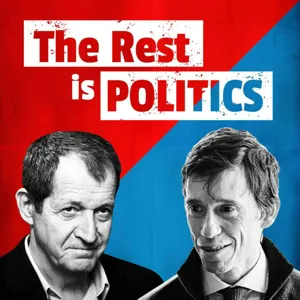Podcast Summary
Understanding Complex Conflicts: Israel-Palestine: Complex conflicts like Israel-Palestine involve individuals and groups experiencing both victimization and perpetration, requiring empathy and open-mindedness for a nuanced understanding and peaceful resolution.
Individuals and nations can find themselves in complex situations where they experience both victimization and perpetration. This idea, proposed by Israeli author Yuval Noah Harari, sheds light on the Israel-Palestine conflict, a long-standing issue that has defied simple solutions. The deep story of this conflict, as explored in the podcast "The Wedding Scammer," can be understood through the emotional truth of feeling like one is being unfairly left behind. However, acknowledging the complexity of the situation and recognizing that individuals and groups can hold multiple roles requires empathy and open-mindedness. This perspective can help foster a more nuanced understanding of complex conflicts and promote dialogue towards finding peaceful resolutions. Listen to "The Wedding Scammer" podcast for a deeper exploration of this concept and the Israel-Palestine conflict.
A brief history of Israel and Palestine: The complex history of Israel and Palestine is marked by periods of rule by various groups, including Jews, Romans, Arabs, Muslims, and Turks, and is rooted in deep stories that motivate actions on both sides, requiring understanding for finding a resolution
The history of Israel and Palestine is complex and multifaceted, with both sides having experienced victimization and perpetrated violence. The late 19th century marked the beginning of Jewish immigration to Palestine, driven by persecution in Europe. Jews and Muslims coexisted in the Ottoman Empire, but tensions rose as Jewish settlements expanded and Arab residents felt displaced. This long and intricate history is marked by periods of rule by various groups, including Jews, Romans, Arabs, Muslims, and Turks. The current conflict is rooted in these historical complexities, and understanding the deep stories that motivate the actions of both sides is crucial for finding a resolution. Benny Morris and Zachary Foster, two historians of this conflict, offer unique perspectives on the history of Israel and Palestine from antiquity to the present day.
Jewish immigration to Palestine in response to anti-Semitism: The emergence of Zionism led to Jewish immigration to Palestine, where they faced complex relations with the Arab population and eventual British involvement, ultimately leading to conflict over land and identity.
The emergence of Zionism in the late 19th century was a response to rising European nationalism and the wave of anti-Semitism, particularly during the pogroms in Russia. Jews began to emigrate to Palestine in small numbers to establish agricultural settlements. Relations between Jews and Arabs were complex, with both groups engaging in trade and labor, but also experiencing friction over land boundaries. The Arabs saw the Jews as strangers and infidels, while the Jews were seen as wealthy intruders. The arrival of the British during World War 1 and the issuance of the Balfour Declaration, which promised a Jewish homeland in Palestine, further complicated the situation and set the stage for the conflicts that would escalate after the war.
Balfour Declaration and Jewish Immigration to Palestine: The Balfour Declaration of 1917 led to increased Jewish immigration and development in Palestine, but also sparked tensions with the Arab population, culminating in the Arab revolt and the eventual establishment of Israel following the Holocaust.
The Balfour Declaration of 1917 marked the beginning of Jewish immigration and eventual sovereignty in Palestine, following centuries of persecution. The British, partly due to Jewish lobbying and feelings of guilt, pledged support for a Jewish national home. This led to increased Jewish immigration and development of the area, but also sparked tensions with the Arab population. Violence and unrest escalated throughout the 1920s and 1930s, culminating in the Arab revolt against British rule and the Peel Commission's proposal to partition Palestine into Jewish and Arab states. However, the Jews accepted the proposal, while the Arabs rejected it, leading to ongoing conflict. The Holocaust, which began during this time, further fueled the Zionist movement's demand for a Jewish state and eventually led to international recognition and support for the establishment of Israel.
The Creation of Israel: Jewish Homeland or Arab Displacement?: The creation of Israel in 1948 was a result of historical tensions and the UN's recommendation for a two-state solution, but was met with resistance from the Arab population, leading to war.
The creation of Israel in 1948 was a result of historical tensions between Jews and Arabs in Palestine, which came to a head after World War II and the Holocaust. The UN's recommendation for a two-state solution, following the Peel Commission, led to the partition of Palestine, but this was met with rejection by the Arab population. The Jews, who had been historically persecuted and unable to protect themselves, saw this as their opportunity for a homeland. The UN's recommendation, which gave Jews a larger share of the land than Arabs despite them being the majority population, was seen as a response to the moral catastrophe of the Holocaust and a solution to the problem of Jewish refugees. However, this decision was met with resistance from the Arab population, leading to the 1948 war. It's important to note that there are differing interpretations of this history, particularly regarding the Balfour Declaration and the perceived unfairness of promising a Jewish national home in a land with a predominantly Arab population. Despite efforts to find a peaceful solution, the conflict ultimately erupted into war.
The 1948 Palestine-Israeli conflict: A complex history of offensives and atrocities: The 1948 conflict was marked by Jewish offensives against Palestinian militias and Arab armies, resulting in the establishment of Israel, but also involved atrocities from both sides, requiring acknowledgement for a nuanced understanding of the conflict's origins and modern implications.
The 1948 Palestine-Israeli conflict was marked by a series of offensives from the Jews against Palestinian militias and later, Arab armies. The Jews, who had accepted the UN's proposed partition of Palestine, found themselves under attack, first by Palestinian Arabs and later by Arab states. The Jews managed to contain and eventually defeat these forces, leading to the establishment of the State of Israel. However, this conflict also involved atrocities committed by both sides, a fact often overlooked in discussions about the conflict's origins. It's essential to acknowledge this complexity as we continue to grapple with the political and social ramifications of the 1948 conflict in the modern world. Despite differing perspectives on the legitimacy of the Zionist enterprise, it's clear that the Jews saw themselves as legitimate inhabitants endorsed by the international community, while the Arabs saw their attacks as countermeasures to a Jewish invasion. Ultimately, the Jews' better organization, morale, and fighting ability allowed them to take control of more territory than what was promised in the UN resolution, leading to a hardened resolve and a sense of miracle in their victory against the Arab invasion.
The 1948 Arab-Israeli War: A Conflict with Deep Historical Roots: The 1948 Arab-Israeli War resulted in significant population displacement and atrocities, with both sides believing they were fighting for their right to the land, leading to ongoing conflict and shaping current events.
The 1948 Arab-Israeli War was a complex conflict with deep historical roots and consequences. Both sides believed they were fighting for their right to the land, leading to a devastating war that resulted in significant population displacement and atrocities committed by both sides. The Jews, feeling vengeful after the Arab attack and loss of life, took control of hundreds of Arab towns and villages, leading to widespread atrocities. The Palestinians, on the other hand, felt that their entire house was being taken away and refused to accept a divided land. The conflict over whose land it truly was lies at the heart of the ongoing Israeli-Palestinian conflict and continues to shape the news today, including the October 7th attacks and the shelling of Gaza. It's crucial to understand this deep historical context before discussing current events.
Control of Gaza Strip: A Contentious Issue: The control of Gaza has been a long-standing issue due to historical conflicts and political restrictions, leading to the rise of militant groups like Hamas.
The control of the Gaza Strip has been a contentious issue since the end of the 1948 Arab-Israeli War. The Egyptian army occupied Gaza and kept the population there, mostly refugees, from becoming Egyptian citizens. Israel took control of Gaza in the 1956 Suez War but returned it to Egypt after making peace with Egypt in 1979. However, when Israel occupied Gaza, the West Bank, and East Jerusalem in 1967, it imposed military orders banning political activity and displaying Palestinian symbols. These restrictions contributed to the growth of Palestinian militant groups like Hamas, which emerged in the late 1980s. The complex history of the region and the ongoing conflict make finding a peaceful solution a significant challenge.
Israeli military's violent response to Palestinian protests leads to Hamas radicalization: The Israeli military's brutal occupation tactics during the first intifada led to the radicalization of Hamas, resulting in their shift towards militancy and eventual rise to power in Gaza.
The Israeli military's brutal occupation of the West Bank and Gaza in the late 1980s led to the radicalization of Hamas, which had initially been an apolitical Islamic charity organization. This period saw widespread Palestinian protests against Israeli military actions, resulting in mass arrests, physical abuse, and property confiscation. The Israeli military response was violent, with over 1200 Palestinians killed and only 160 Israelis killed during the first intifada from 1987 to 1993. This extreme violence against innocent Palestinians, particularly children, radicalized Hamas, leading them to begin attacking Israeli civilians for the first time in December 1990. The Israeli military's violent actions against Palestinian protesters continued, culminating in the infamous massacre of 22 Palestinians in October 1990. These events set the stage for Hamas' transition into a militant political power, eventually winning elections in Gaza in 2006.
Hamas' Rise to Power and the Israeli Blockade of Gaza: The Israeli blockade of Gaza, deemed illegal by the UN, caused extreme poverty and hardships for the Gazan population, while Hamas' autocratic rule and economic control added to their dissatisfaction.
Hamas came to power in the Palestinian legislative elections in January 2006, leading to a civil war and subsequent Israeli blockade of Gaza. This blockade, which the UN deemed illegal under international law, resulted in a state of siege and extreme poverty for the Gazan population. While Hamas' rejection of Israel's right to exist was a justification for the blockade from the Israeli perspective, the primary issue for Gazans is the Israeli blockade and the hardships it causes. Additionally, Hamas' autocratic rule and heavy-handed economic control have led to dissatisfaction among the population, particularly young people.
Palestinian political division hinders peace resolution: The ideological differences, international pressure, and deliberate actions by Israeli leaders have prevented the formation of a unified Palestinian political movement capable of negotiating a peaceful resolution with Israel, worsening the humanitarian crisis in Gaza.
The political division between Fatah and Hamas in the Palestinian territories has hindered the possibility of a peaceful resolution between Israel and the Palestinians. The failure of Hamas to reconcile with Fatah, driven by ideological differences, pressure from the international community and Israeli leaders, and deliberate actions by Israeli leaders to strengthen Hamas and weaken Fatah, has prevented the formation of a unified and powerful political movement capable of negotiating a two-state or three-state solution with Israel. The humanitarian situation in Gaza prior to the 2014 attack was already dire, with the UN warning that it would be unlivable by 2020. This highlights the urgent need for a political solution to the conflict.
Crisis in Gaza: Water, Food, and Electricity Scarcity: The political instability in Gaza, exacerbated by Israel's past policies, has led to a humanitarian crisis with waterborne illnesses, food handouts, and electricity shortages. A peaceful resolution through negotiations is necessary but challenging due to Hamas' potential to rebuild military infrastructure.
The situation in Gaza is dire, with many people lacking access to fresh water, relying on food handouts, and facing an electricity crisis. These issues have led to a high rate of waterborne illnesses. The political instability in Gaza, fueled in part by Israel's past policies of bolstering Hamas, has contributed to the despair and hopelessness among the population. The recent attack on Israel by Hamas, which resulted in the deaths of over 1,400 people, has left many questioning the necessity of Israel's military response. From a leftist perspective, the argument is made that a ceasefire and peace negotiations are the solution. However, the concern is that if Hamas remains in power, they will rebuild their military infrastructure and potentially launch another attack. This is a complex issue with no easy answers, but it's clear that the situation in Gaza requires urgent attention and a peaceful resolution.
The Destruction of Hamas in Gaza Won't Bring Lasting Peace: A two-state solution may be the ultimate answer, but deep-rooted conflicts and shifting political landscapes make it a complex and challenging issue.
The destruction of Hamas in Gaza would not bring a lasting peace, as the population there, estimated to be around 2.3 million, would continue to harbor resentment towards Israel and potentially produce a new generation of militants. The speaker suggests that a two-state solution between Israel and the Palestinian Arabs, with Israel in its pre-1967 borders and the Arab states controlling the West Bank, Gaza Strip, and most of East Jerusalem, might be the ultimate solution. However, this idea has never been agreed upon by both sides due to deep-rooted conflicts and shifting political landscapes. The Israeli public and governments have moved towards the far right, with a growing settlement enterprise in the West Bank, while the Palestinian side lacks strong mainstream moderates and liberals. The speaker also mentions the emergence of new political movements among young Palestinians, some of which are militant while others are more peace-seeking. Ultimately, finding a peaceful and lasting solution to the Israeli-Palestinian conflict remains a complex and challenging issue.
Decades of violence and lack of moderate presence fuel the Israeli-Palestinian conflict: The Israeli-Palestinian conflict is marked by decades of violence, lack of moderate voices, and the dominance of extremist groups, making a peaceful solution increasingly elusive
The Israeli-Palestinian conflict has been marked by decades of violence and tragedy, with both sides dealing harshly with each other. The peace process has atrophied, leaving war as the only viable option for both Israelis and Palestinians. Additionally, there is a significant lack of a moderate or liberal presence in the conflict, with both Israel's far-right government and Hamas's abhorrent regime dominating the scene. This missing middle is a crucial issue that will be explored further in our next episode. The toxic symbiosis between these extremist groups makes it nearly impossible for moderates to gain power or influence in the conflict. The tragic history of this conflict sets the stage for continued violence and makes finding a peaceful solution increasingly difficult.




